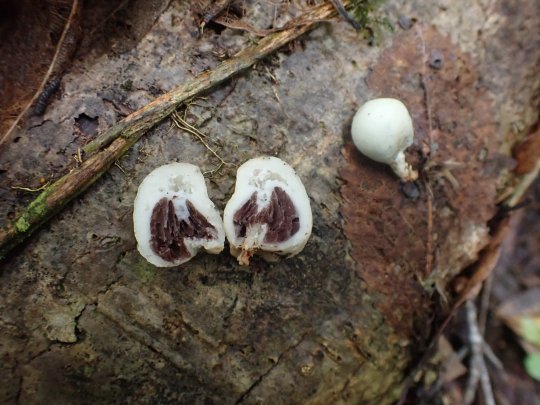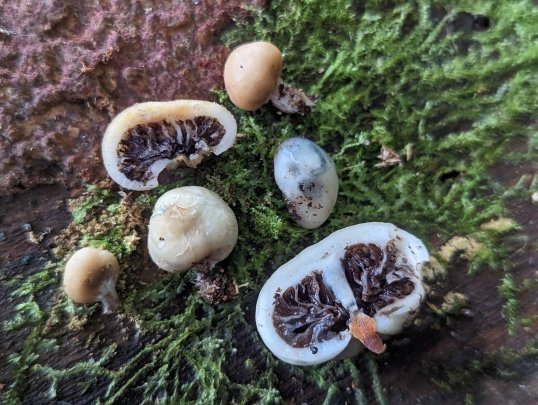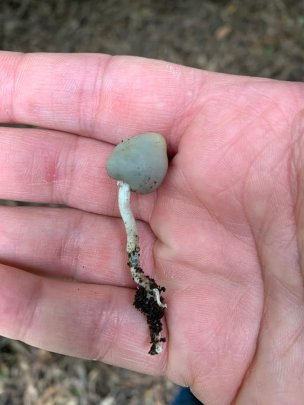Psilocybe weraroa
Description
🌏 Endemic to New Zealand: Psilocybe weraroa, a pouch-like psychoactive mushroom, thrives in New Zealand's lush, native forests, hiding among decaying wood and leaf litter. Often found near rotting branches of native trees like Melicytus ramiflorus and cabbage trees, it emerges during early winter and spring. These curious fungi blend with their surroundings and are frequently partially eaten by slugs, who also help spread their spores, as the mushroom doesn’t release spores through its enclosed gills! 🐌🍂
🔬 Closely Related to Bluing Psilocybes: Though Psilocybe weraroa has an unusual, pouch-like form, phylogenetic research shows it is closely related to the hallucinogenic Psilocybe cyanescens and Psilocybe subaeruginosa, sharing similar psychoactive compounds—psilocybin and psilocin. This unique lineage also connects with traditional Māori healing practices (Rongoā Māori) and has caught the eye of modern science for its potential medicinal applications.
📜 Historical Classification: Originally classified as Secotium novae-zelandiae by New Zealand mycologist Gordon Cunningham in 1924, it was later renamed Weraroa novae-zelandiae by Rolf Singer in 1958. Recent molecular studies by mycologists like Borovička and Moncalvo in the early 2000s confirmed the mushroom’s close ties to Psilocybe species, prompting its reclassification as Psilocybe weraroa.
🔎 Identification Tips: Psilocybe weraroa can be challenging to identify. Its secotioid form—a closed cap with a lumpy structure—never opens to reveal gills, requiring cross-sectioning for accurate ID. It is often confused with similar pouch-like mushrooms like Clavogaster virescens, which is non-psychoactive and has no bluing. 🌌
🍄 An Elusive Beauty: Found in mixed lowland rainforests around Auckland and Wellington, this mushroom is rare, with most specimens showing signs of slug damage. Unlike typical gilled mushrooms, Psilocybe weraroa’s spores aren’t forcibly discharged. Instead, it relies on the surrounding fauna to help spread its spores and can linger in the forest for months if left uneaten.
Mushroom Identification
🍄 Pileus (Cap/Peridium):
-
Size & Shape: 1.18 to 1.97 inches (3 to 5 cm) long by 0.59 to 1.38 inches (1.5 to 3.5 cm) wide, varies from round and egg-shaped to elongated and elliptical.
-
Color & Texture: Starts light brown, turns pale blue-grey or even pallid green as it ages, drying to yellow or dingy brown. Finely striated when young, smooth, polished, and leathery with age.
-
Other Features: The cap is tacky, glabrous, with a folded and sometimes torn margin. Bruises slowly to blue or greenish when handled.
🌱 Stem:
-
Size & Shape: Up to 40 mm tall by 6 mm thick, slender, hollow, with a yellow-orange inner flesh thickening at the apex.
-
Color & Texture: Whitish to french-grey, bruising blue or greenish with damage. Yellowish-brown at the base, smooth and polished over time, except near the base.
🍫 Gleba (Inner Flesh):
-
Color & Structure: Sepia-brown to chocolate-brown, sometimes purple-brown; sparse, chambered, and twisted into gill-like, elongated shapes.
🎨 Bruising & Spore Print:
-
Bruising: Blue or greenish, though inconsistent across the mushroom.
-
Spore Print: Not possible due to its secotioid (pouch-like) form.
🌲 Habitat & Distribution:
-
Location: Found in New Zealand, primarily on decaying wood, often near streams. Common in native forests, especially in the Wellington region.
-
Growth Pattern: Solitary or in small groups on decaying leaf litter, rotting branches, and various tree-fern fronds. Grows year-round, occasionally on wood chips or the decaying wood of native plants such as mahoe, kahikatea, kohekohe, and ponga.
Photo sources:
Photo 1 - Author: Alan Rockefeller (CC BY 4.0)
Photo 2 - Author: Kelvin Perrie (CC BY 4.0)
Photo 3 - Author: Alan Rockefeller (CC BY 4.0)
Photo 4 - Author: eyrezer (CC BY 4.0)




